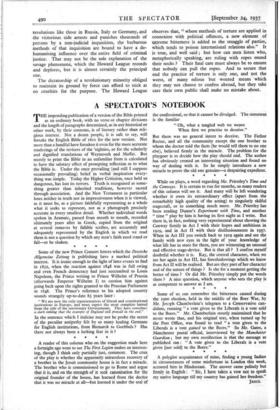A SPECTATOR'S NOTEBOOK
THE impending publication of a version of the Bible printed as an ordinary book, with no verse or chapter divisions and the length of paragraphs determined, as in any historical or other work, by their contents, is of literary rather than reli- gious interest. Not a dozen people, it is safe to say, will forsake the English Bible of 1611 for the new version. Not more than a handful have forsaken it even for the more accurate renderings of the revisers of the 'eighties, or for the scholarly and dignified translations of Weymouth and Moffat. But merely to print the Bible in an unfamiliar form is calculated to have the salutary effect of prompting reflection as to what the Bible is. Under the once prevailing (and still I suppose occasionally prevailing) belief in verbal inspiration every- thing was simple. Today the Higher Criticism, once held so dangerous, has lost its terrors. Truth is recognised as some- thing greater than inherited traditions, however sacred through association. And the New Testament in particular loses neither in truth nor in impressiveness when it is viewed, as it must be, as a picture faithfully representing as a whole what it seeks to represent, not as a photograph precisely accurate in every smallest detail. Whether individual words spoken in Aramaic, passed from mouth to mouth, recorded ultimately years after in Greek, copied from the original at several removes by fallible scribes, are accurately and adequately represented by the English in which we read them is not a question by which any man's faith need stand or fall—or be shaken.
* * *. *


















































 Previous page
Previous page